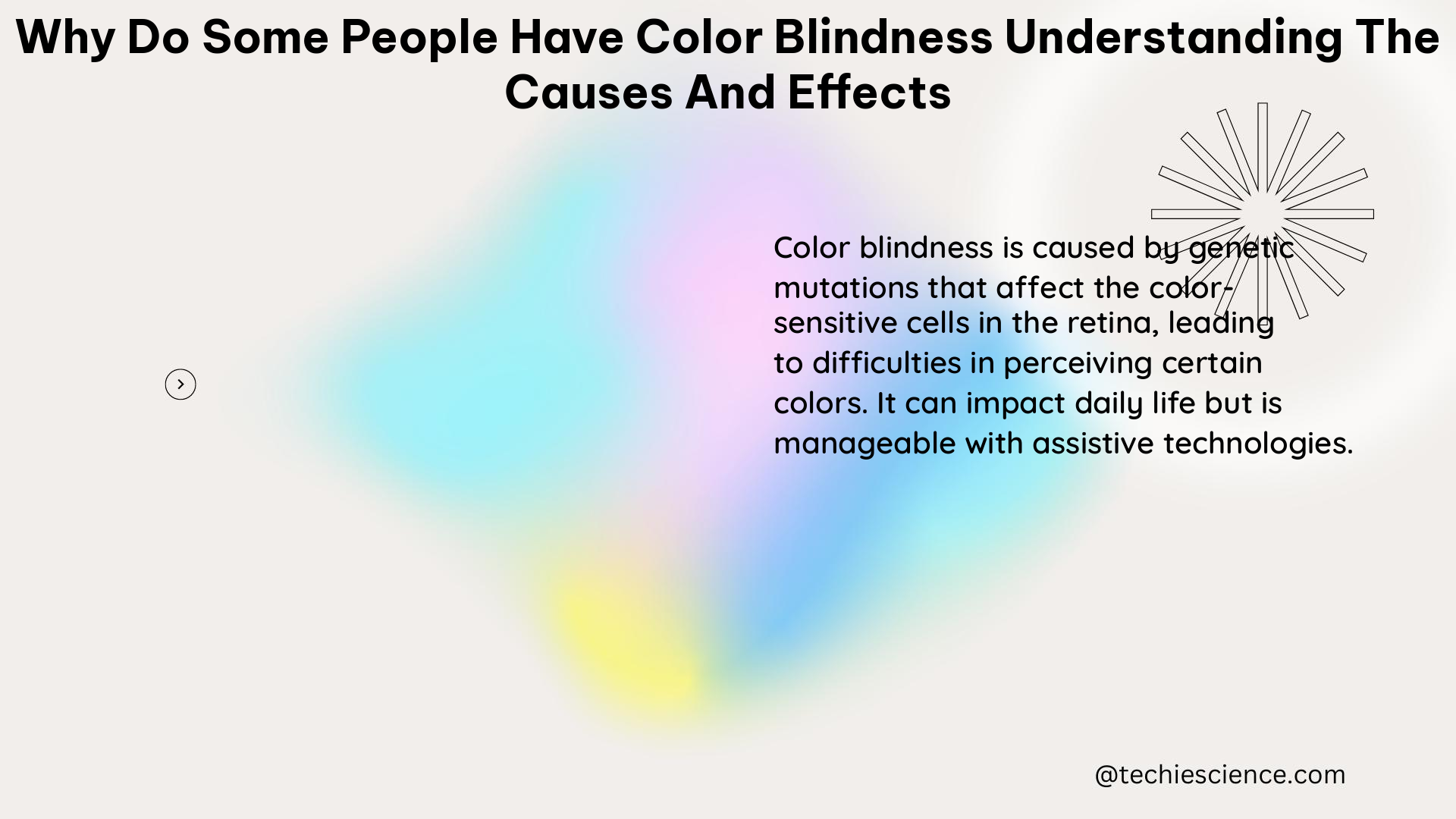Color blindness, also known as color vision deficiency, is a condition where an individual’s ability to perceive colors is impaired. This condition affects approximately 8% of men and 0.5% of women of Northern European ancestry, with the most common form being red-green color blindness, which affects about 1 in 12 people assigned male at birth (AMAB) and 1 in 200 people assigned female at birth (AFAB) of Northern European ancestry.
Causes of Color Blindness
The causes of color blindness can be either inherited or acquired. Understanding the underlying mechanisms is crucial for managing and accommodating individuals with this condition.
Inherited Color Blindness
Inherited color blindness is caused by a genetic mutation that affects the way the eyes process color. The most common form, red-green color blindness, follows an X-linked recessive inheritance pattern, meaning it is more prevalent in individuals AMAB and rare in individuals AFAB.
The genes responsible for color vision are located on the X chromosome, and a mutation in these genes can lead to different types of red-green color blindness, such as:
- Protanopia: Reduced sensitivity to red light, causing difficulty distinguishing between red and green hues.
- Deuteranopia: Reduced sensitivity to green light, causing difficulty distinguishing between red and green hues.
- Protanomaly: Reduced sensitivity to red light, causing a shift in color perception.
- Deuteranomalya: Reduced sensitivity to green light, causing a shift in color perception.
The inheritance pattern of these conditions can be explained by the following Punnett square:
| X^R | X^r | |
|---|---|---|
| X^R | X^R X^R (Normal) | X^R X^r (Carrier) |
| X^r | X^R X^r (Carrier) | X^r X^r (Color Blind) |
In this Punnett square, X^R represents the normal color vision allele, and X^r represents the color blindness allele. Individuals AMAB who inherit two copies of the color blindness allele (X^r X^r) will have the condition, while individuals AFAB who inherit one copy of the color blindness allele (X^R X^r) will be carriers but not affected.
Acquired Color Blindness
Acquired color blindness, on the other hand, develops later in life and can be caused by various factors, such as:
- Eye Diseases: Conditions like cataracts, glaucoma, and macular degeneration can affect the eye’s ability to process color information.
- Brain Injuries: Damage to the visual cortex or other parts of the brain responsible for color processing can lead to acquired color blindness.
- Exposure to Certain Chemicals: Exposure to chemicals like carbon monoxide, lead, or certain solvents can also cause acquired color blindness.
The specific mechanisms by which these factors lead to color blindness vary and depend on the underlying cause.
Effects of Color Blindness

The effects of color blindness can vary depending on the severity and type of the condition. Individuals with color blindness may experience the following:
- Difficulty Distinguishing Colors: People with color blindness may have trouble distinguishing between certain colors, such as red and green or blue and yellow.
- Reduced Color Perception: Color blindness can affect the perceived brightness and intensity of colors, making it difficult to appreciate the full range of color.
- Challenges in Daily Tasks: Color blindness can impact various daily activities, such as driving, choosing clothing, identifying ripe fruits and vegetables, and interpreting color-coded information.
Quantifiable data on the effects of color blindness includes:
- Reduced Sensitivity to Specific Colors: Studies have shown that individuals with red-green color blindness have a reduced sensitivity to either red or green light, which affects their ability to distinguish between these colors. For example, people with deuteranomaly have a reduced sensitivity to green light, causing yellow and green to appear redder.
- Decreased Performance in Color-Related Tasks: Research has demonstrated that people with color blindness have a reduced ability to perform color-related tasks, such as color matching or identifying the color of objects in different lighting conditions. This can impact their ability to perform certain jobs or activities that require accurate color perception.
To diagnose color blindness, eye care providers use various tests, such as the Ishihara test, which involves identifying numbers or shapes in a series of color plates. These tests can help determine the type and severity of the condition, which is crucial for managing its effects and providing appropriate accommodations.
In summary, color blindness is a condition that affects the way people perceive colors, and it can be caused by inherited or acquired factors. Understanding the underlying causes and the measurable effects of color blindness is essential for managing and accommodating individuals with this condition.
References:
– National Eye Institute. (2023-11-15). Color Blindness | National Eye Institute. Retrieved from https://www.nei.nih.gov/learn-about-eye-health/eye-conditions-and-diseases/color-blindness
– Mayo Clinic. (2019-12-28). Color blindness – Symptoms and causes – Mayo Clinic. Retrieved from https://www.mayoclinic.org/diseases-conditions/poor-color-vision/symptoms-causes/syc-20354988
– WebMD. (2023-09-01). Color Blindness: How It Happens and What Causes It – WebMD. Retrieved from https://www.webmd.com/eye-health/color-blindness
– Cleveland Clinic. (n.d.). Color Blindness: Types, Causes & Treatment – Cleveland Clinic. Retrieved from https://my.clevelandclinic.org/health/diseases/11604-color-blindness
– National Eye Institute. (2023-08-07). Causes of Color Vision Deficiency | National Eye Institute. Retrieved from https://www.nei.nih.gov/learn-about-eye-health/eye-conditions-and-diseases/color-blindness/causes-color-vision-deficiency

The lambdageeks.com Core SME Team is a group of experienced subject matter experts from diverse scientific and technical fields including Physics, Chemistry, Technology,Electronics & Electrical Engineering, Automotive, Mechanical Engineering. Our team collaborates to create high-quality, well-researched articles on a wide range of science and technology topics for the lambdageeks.com website.
All Our Senior SME are having more than 7 Years of experience in the respective fields . They are either Working Industry Professionals or assocaited With different Universities. Refer Our Authors Page to get to know About our Core SMEs.